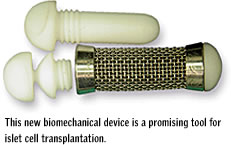 Diabetes is a vexing foe. In patients with type 1 diabetes,
the ability to produce insulin is severely impaired by the
immune
system, which destroys insulin-producing islet cells in the
pancreas. Replacing the cells is possible thanks to Camillo
Ricordi, M.D.,
scientific director and chief academic officer of the Diabetes
Research Institute (DRI), who developed a method for the efficient
isolation of islets from the donor pancreas for transplantation. Diabetes is a vexing foe. In patients with type 1 diabetes,
the ability to produce insulin is severely impaired by the
immune
system, which destroys insulin-producing islet cells in the
pancreas. Replacing the cells is possible thanks to Camillo
Ricordi, M.D.,
scientific director and chief academic officer of the Diabetes
Research Institute (DRI), who developed a method for the efficient
isolation of islets from the donor pancreas for transplantation.
“Isolated islets are currently transplanted into the liver
of patients with diabetes, where they start producing insulin
and
can restore metabolic control,” says Ricordi. The islets
are injected into the portal vein, the main blood vessel into
the liver. While the DRI has had great success with that method
for decades, there are problems.
“The injection of islet cells into the blood in the
portal vein results in the generation of inflammation that
compromises their
viability,” says Luca Inverardi, M.D., director of immunobiology
of islet transplantation at the DRI. “Many of those cells
fail.”
A new biomechanical device may eliminate all of the problems
that characterize the current transplant site.
It is hollow, with a porous screen mesh and a solid plastic
cylinder inside. In experimental models, the device was implanted
40 days
before islet transplantation in order to allow blood vessels
to grow around and through the chamber, giving it resilience
and stability. Then the cylinder was removed, and compatible
islet cells were injected into the hollow center. In testing,
within hours the islets were producing and delivering insulin
through vibrant new blood vessels, production that continued
over time.
“
It would be highly desirable to find an alternative to the liver
as the site of these transplants,” says Antonello Pileggi,
M.D., research professor of surgery at the DRI. “This device
is very promising and seems to have long-term reliability in
these initial experimental models.”
“Successful reversal of diabetes with this device is quite
exciting,” says
Ricordi. “It opens the possibility of creating a bio-artificial
organ that could replace the current practice of injecting islets
into the liver.”
The DRI is currently extending the studies with clinical
trials in mind.
|